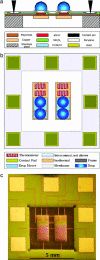Enthalpy arrays
- PMID: 15210951
- PMCID: PMC470707
- DOI: 10.1073/pnas.0403573101
Enthalpy arrays
Abstract
We report the fabrication of enthalpy arrays and their use to detect molecular interactions, including protein-ligand binding, enzymatic turnover, and mitochondrial respiration. Enthalpy arrays provide a universal assay methodology with no need for specific assay development such as fluorescent labeling or immobilization of reagents, which can adversely affect the interaction. Microscale technology enables the fabrication of 96-detector enthalpy arrays on large substrates. The reduction in scale results in large decreases in both the sample quantity and the measurement time compared with conventional microcalorimetry. We demonstrate the utility of the enthalpy arrays by showing measurements for two protein-ligand binding interactions (RNase A + cytidine 2'-monophosphate and streptavidin + biotin), phosphorylation of glucose by hexokinase, and respiration of mitochondria in the presence of 2,4-dinitrophenol uncoupler.
Figures







References
-
- Weber, P. C. & Salemme, F. R. (2003) Curr. Opin. Struct. Biol. 13, 115-121. - PubMed
-
- Leavitt, S. & Freire, E. (2001) Curr. Opin. Struct. Biol. 11, 560-566. - PubMed
-
- Wiseman, T., Williston, S., Brandts, J. F. & Lin, L. (1989) Anal. Biochem. 179, 131-137. - PubMed
-
- Scott, L. G., Tolbert, T. J. & Williamson, J. R. (2000) Methods Enzymol. 317, 18-38. - PubMed
-
- Stryer, L. (1995) Biochemistry (Freeman, New York), 4th Ed., p. 553.
MeSH terms
Substances
LinkOut - more resources
Full Text Sources
Other Literature Sources

